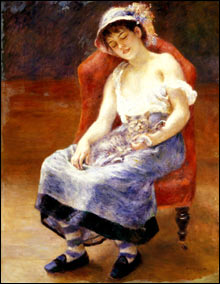7/28/2006 9:34:30 AM

Renoir’s Sleeping Girl with a Cat
|
Their taste in art, like their personalities, overlapped and didn’t. Stephen bought things he thought he could show in his homes, and he didn’t hesitate to trade in one piece to make way for another. Sterling bought with an eye to a museum that would one day house his collection and attest to his acumen; much of his collection lived in storage. Sterling frequently derided Stephen’s purchases, as well as those of other collectors; Stephen seems not to have noticed what Sterling was buying. Stephen lent his pieces frequently, Sterling seldom. Sterling’s tastes were more European and Impressionist, Stephen’s more American and contemporary. Both men liked Renoir, Homer, and Sargent, though Sterling was the more enthusiastic collector. Sterling favored Bouguereau (the mammoth Nymphs and Satyr), Corot, Degas, Morisot, Monet; Stephen preferred Seurat, Cézanne, Matisse, Picasso, Edward Hopper. Sterling’s Sargents include the white-on-white Fumée
d’ambre gris, A Venetian Interior, and A Street in Venice; he must have appreciated the Henry Jamesian subtlety with which Sargent balanced European and American. (James himself wrote favorably of Fumée d’ambre gris for Harper’s.) He seems the more voyeuristic of the two (the Bouguereau, Gérôme’s The Snake Charmer, Renoir’s Blonde Bather), and the more given to theatricality (Remington’s The Scout: Friends or Foes and Dismounted: The Fourth Trooper Moving the Led Horses; Renoir’s Sleeping Girl with a Cat; Homer’s Undertow). Stephen first made a name for himself as a collector of Matisse; in the 1940s, however, he began to sell off his canvases, and by 1950 he had only one left. He was an early Hopper supporter, yet many of his Hoppers were donated to museums, as if as an unsettling work like Rooms by the Sea, which he had snapped up almost as soon as it was painted, were too unsettling to live with. (Or were they too unsettling for Susan?) His triumph in this show is his quintet of Cézannes, which include Still Life with Ginger Jar and Eggplants and a version of The Cardplayers. He traded Corot’s Castel Sant’Angelo in as part payment for Cézanne’s The Pool at the Jas de Bouffan;
Sterling promptly bought the Corot, commenting that he would not trade it “for all the Cézannes in existence.” Sterling’s Van Gogh was the 1886 Terrace in the Luxembourg Garden, Vincent in his brief Corot period. Stephen’s was the 1888 Night Café, Vincent anticipating Hopper, explaining that he was trying “to express the idea that the café is a place where one can ruin oneself, go mad or commit a crime.”
In 1929, Stephen became a founding board member of the Museum of Modern Art; a few years later, he was also elected to the Met board, and he made generous donations to both museums. He helped establish the Farmers’ Museum and Baseball’s Hall of Fame in Cooperstown and persuaded the New York Historical Society to move there from Ticonderoga. Sterling and Francine were weaned from France by the two world wars; Sterling, in search of a home for his collection, considered the Petit-Palais in Paris and the Virginia Museum of Fine Arts in Richmond and a museum he would himself build on the Upper East Side, but in the end he hit on a Cooperstown that he could call his own: Williamstown, where his grandfather had gone to college. (The exhibition catalogue could have said more about Sterling’s interest in horse breeding and racing; the museum at least has photographs and film footage of his Never Say Die winning the Derby and the St. Leger in 1954.) It’s easy to see Sterling as more self-absorbed and less public-spirited than his brother, but Stephen had his own stubborn streak, leaving both the Met board and MoMA’s acquisitions committee over disagreements, and the paintings MoMA had hoped to inherit from him went instead to the Met and to Yale. Sterling is more giving of himself in his journals and letters, and also of his feelings about his wife; he and Francine are lit up while Stephen and Susan stand off in the shadows.
At the Clark, paintings like Renoir’s Still Life with Peaches (Stephen) and his Onions (Sterling) hang side by side, the collector clearly but not conspicuously identified in vertical block letters, so that at a normal viewing distance you have to ask yourself which brother bought it and why, and close up the wall texts help explain why you were right or wrong. This is more than a entertaining museum game; it’s the process of understanding not only the two Clarks’ tastes but also the development of late-19th- and early-20th-century art. The answers, as the ownership of the two Degas self-portraits in the first room and Renoir’s Madame Henriot in Costume attests, aren’t always obvious. Neither were Sterling and Stephen.
“THE CLARK BROTHERS COLLECT: IMPRESSIONIST AND EARLY MODERN PAINTINGS" | STERLING AND FRANCINE CLARK INSTITUTE OF ART, WILLIAMSTOWN | THROUGH SEPTEMBER 4
ADVERTISEMENT
 |
|
 |
|
|
- SEX (CIRCA 2006) Oral is the new second base, the “mostly” girls keep on kissing girls, and the Bro Job has arrived (but is still not ready for its close-up)
- WHAT NOW? Republican defeats are just the first step in turning the nation around. Plus, the constitutional imperative of gay marriage.
- THE NAKED SORORITY Never mind its tough-girl alt-porn feminism: SuicideGirls has already moved on to a new generation
- WHATEVER HAPPENED TO MEMOGATE? Waiting for the Globe’s mea culpa
- COP OR DRUG DEALER? Roberto Pulido’s story shows how easily the divide between law-keepers and law-breakers can break down — if nobody is paying attention
- HARMONIC INSURGENTS The graphic intensity of Converge
|

|